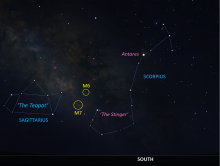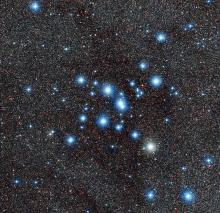Listen to today's episode of StarDate on the web the same day it airs in high-quality streaming audio without any extra ads or announcements. Choose a $8 one-month pass, or listen every day for a year for just $30.
You are here
Scorpius
Our brains tend to find patterns just about everywhere. Some of them are real, but many are just imagined. A cloud, for example, might look like a dragon or a fairy-land castle. An eroded mesa on Mars can look like a human face. And patterns of stars might look like a dolphin, a lion, or a scorpion.
In fact, the celestial scorpion is one of the highlights of summer nights. It’s in the south as darkness falls, quite low above the horizon, and wheels across the southwest later on. Many cultures have seen a wide head, a slightly curved body, and a sharply curved tail complete with stinger — the perfect outline of a scorpion.
The outline itself is just a coincidence. But the fact that so many bright stars appear in that part of the sky isn’t. Scorpius is embedded in the hazy band of light known as the Milky Way — the glow of countless stars that define the disk of the Milky Way galaxy. And it’s roughly in the direction of the galaxy’s heart, where we’re looking into a great thicket of stars. So it’s like gazing into the densest part of a forest — there are big trees everywhere you look.
Clouds of gas and dust in that direction are giving birth to many new stars. Many of these newborns are especially big and bright — stars that really stand out. Several of these standouts are among the stars that form the pattern that we see as the scorpion.
Three of these stars form the scorpion’s head, and we’ll have more about them tomorrow.
Script by Damond Benningfield






